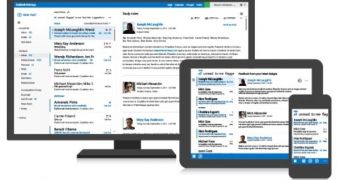Following the launch of Office 2013 Customer Preview and the availability of a preview flavor of the Outlook.com email service, Microsoft has unveiled that the new Outlook Web App (OWA) is now available for tablet and smartphone users as well.
The main purpose of OWA was to provide users with access to their email inboxes through the same Outlook UI and functionality as on the application available for desktop computers.
However, since the screens of tablet PCs and phones are different from those of desktop computers, different user interface requirements are in place.
To ensure that the same great experience is available across all devices, Microsoft worked on delivering an OWA application that could easily scale on different screen sizes and that it would support different input methods, including touch, mouse and keyboard.
Here are some of the enhancements the new OWA comes with: - For screens found on laptops or larger devices, OWA projects a UI optimized for mouse and keyboard input. We refer to this mode as “Desktop.” - For tablet size screens, OWA projects a UI optimized for touch input. We refer to this as “touch-wide.” - For phone size screens, OWA projects a narrower UI for touch. This is “touch-narrow.”
However, the application logic that is running underneath the UI remains the same in all three cases, which means that the same functionality and capabilities will be available for users regardless of the type of device.
The new Outlook Web App comes with the same design language that is found in Windows 8 and Windows Phone and in the newly released Office 2013 suite (the popular Metro UI).
This clean look provides users with the possibility to focus more on the content of their emails and conversations, and be less distracted. There are also a simplified visual language and interaction models to provide a better experience than before.
“To help users avoid context switching, we also added email inline compose in the main window. Users can pop out certain compose forms, or change a setting to have all compose forms pop out automatically,” Kristian Andaker, principal group program manager of exchange, notes in a blog post.
“Although we have spent a lot of time ensuring the default colors of OWA will feel great, different people have differing tastes, so the OWA capability of selecting a different theme has been enhanced with more themes that affect more aspects of the UI for a more delightful experience.”
These are only some of the enhancements the new Outlook Web App has been packed with. For a more detailed look at it, head over to the aforementioned blog post on Office Next.

 14 DAY TRIAL //
14 DAY TRIAL //